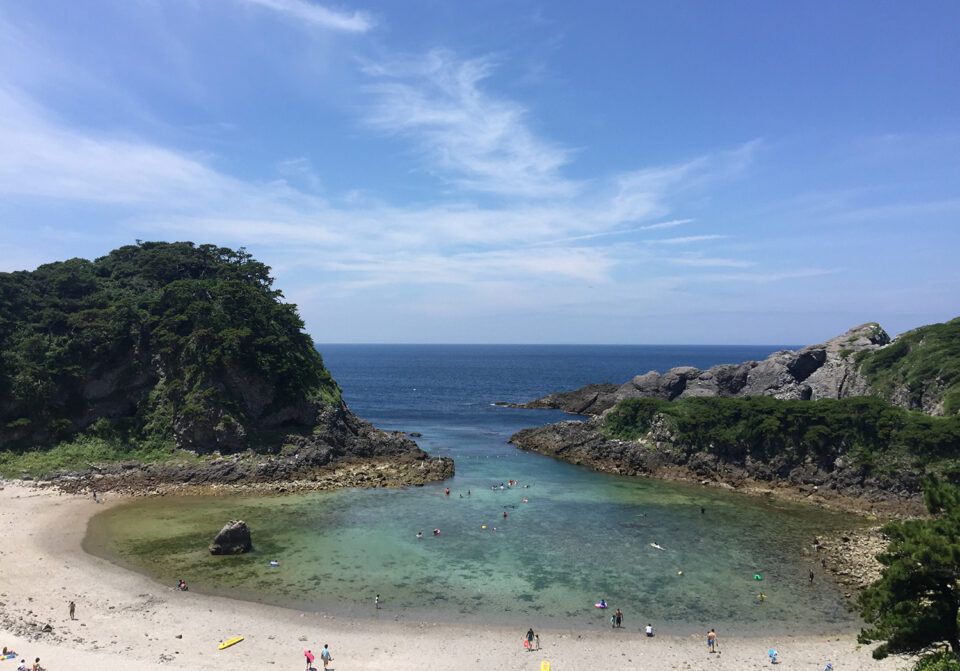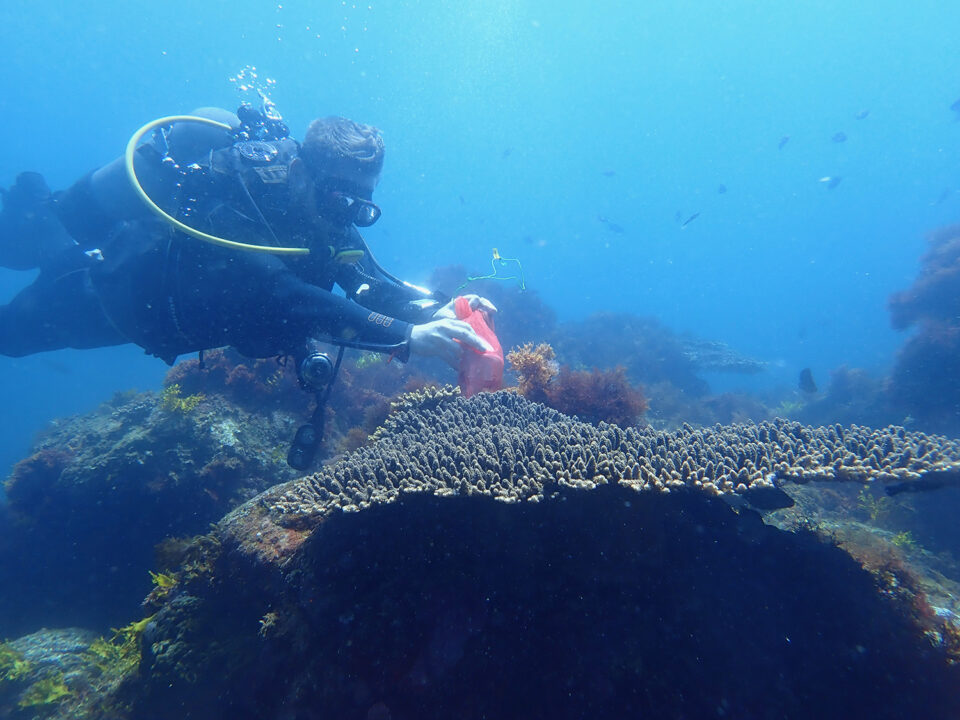Kelp and abalone have disappeared off Shikinejima but the excess carbon dioxide in the water there offers useful lessons for aquaculture

The volcanic island of Shikinejima is more than 100 kilometers (62 miles) from Tokyo. Many people know it as a paradise for scenic getaways and relaxing vacations. But what they don’t know is that the seas surrounding the island offer a glimpse into how the ocean could behave in future, not just in Japan but across the world.
Over the last 10 to 20 years, species such as kelp (Laminariales) and abalone (Haliotis) have been declining significantly off the coast of Shikinejima due to ocean warming and acidification. Researchers at the University of Tsukuba are now describing the ecosystem as “simple,” which means that it’s losing biodiversity and complexity. Meanwhile, the island has long been of interest to them due to underwater volcanoes that release an unusually large amount of carbon dioxide (CO2) into surrounding waters. Researchers believe this offers great potential for studies into the effects of ocean acidification and are investigating how marine life can survive in less alkaline waters.
“Shikinejima is home to what we call carbon dioxide seeps,” Dr. Sylvain Agostini of Shimoda Marine Research Center at the University of Tsukuba told the Advocate. “This means that there is CO2 bubbling out from the sea floor in the water column and its concentration is the same high concentration that we expect to see in future. Through our research, we are beginning to see how the ecosystem might develop under such high CO2 levels.”
If conditions off Shikinejima become more widespread, there will be increased changes in benthos, species’ habitats and different effects on fish communities. Some species are likely to remain or increase because their preferred food may increase in acidified conditions, while others, such as species whose habitat is coral, will disappear along with the coral. There may also be direct effects on fish behavior such as their ability to detect predators, but it is currently unclear which species will be affected and how.
Increased CO2 levels also cause calcium carbonate ions – important building blocks for coral and shellfish shells – to be less abundant. In the long-term, it’s possible that species such as kelp will be replaced by simpler turf algae. Meanwhile, the people of Shikinejima have seen their ecosystem change, as species such as abalone and intertidal hijiki seaweed (Sargassum fusiforme) that were once common are no longer available for consumption or sale.
With many economies dependent on fish and shellfish and people worldwide relying on seafood as their primary source of protein, what do the conditions off Shikinejima signify for aquaculture? Professor Jason Hall-Spencer of the School of Marine Science and Engineering at Plymouth University in the UK and a Research Professor at the University of Tsukuba, says that what’s happening off Shikinejima is not all doom and gloom. Not only do CO2 seeps indicate what species can and can’t survive, he says, but they may also have positive implications for aquaculture.
Quantifying greenhouse gas emissions from global aquaculture
“A lot of seaweed does really well at high CO2,” he explained. “When it’s harvested, carbon dioxide is removed from the water. This helps ocean acidification while farms provide an opportunity for jobs and livelihoods. Seaweed can also help tackle eutrophication by removing harmful nutrients such as nitrates and phosphates. Some species, such as calcified seaweeds like coralline algae, don’t do so well in CO2 seeps but aquaculture could stimulate the growth of some of these.”
Could shellfish also be farmed off Shikinejima? In recent years, oysters in the United States have failed to grow in aquaculture facilities and natural ecosystems on the West Coast. This appears to be due to naturally occurring upwelling events that lower the ocean’s pH, while anthropogenic CO2 is also having an impact. However, in the Mediterranean, where some areas have similar conditions to Shikinejima, mussels and oysters appear to do badly for another reason – a lack of food. This is in contrast to countries such as the United Kingdom or Germany, where the sea is rich in phytoplankton that oysters and mussels feed on.
Uncertain times for oyster larvae production in North America
“Our research into the effects of ocean acidification on shellfish shows that results in the Mediterranean differ from those in the Baltic because of food availability,” said Hall-Spencer. “Oysters or mussels growing off Norway, for example, are unlikely to be damaged by ocean acidification as there is plenty of food in the water. In fact, CO2 stimulates the growth of phytoplankton while the sea off Norway also contains naturally high levels of calcium carbonate. But in the Mediterranean, where there are relatively low nutrients in the water, farms that rely on bivalve filter feeders will struggle because ocean acidification would be an extra stressor on top of a lack of food and warming seas.”
Although not as high as the Baltic, the nutrient concentration off Shikinejima is not as low as the Mediterranean, according to Agostini. With the addition of CO2, some plankton, especially phytoplankton such as diatoms, could increase and be a food source for filter feeders. While research continues, Agostini and his team also believe that there is potential to work with aquaculture in an advisory capacity by identifying species that may be threatened in future and helping to develop rearing techniques for them as a safeguarding measure. It may also be possible to breed genetic strains of organisms that are more resistant to ocean acidification, according to Hall-Spencer.

“It’s currently unclear how aquaculture will fare off Shikinejima,” said Agostini. “A decrease in pH may reduce the growth rate of some species or there may be less produce available to harvest. Regular feeding could help maintain a higher growth rate but if there is a lot of invasion by species such as turf algae, some biological control may be required. New challenges could arise. Having said that, CO2 seeps could be a solution to testing future aquaculture techniques.”
“CO2 seeps will never attract mass aquaculture production as they are so localized and patchy,” added Hall-Spencer. “Growing food there wouldn’t be feasible, but it is possible to find out experimentally what will and won’t survive. In fact, we would encourage such experiments and we are very open to collaborating with aquaculture. They have the equipment for caging, housing and growing organisms at sea, while we have a perfect test site.”
Increased ocean acidification will undoubtedly change the growth and abundance of marine organisms, affecting not only the ecosystem but also the food chain. Proposed actions to reduce its impacts include adapting human activities by reducing CO2 emissions and pollution levels, both locally and globally, said Agostini. By studying other CO2 seeps in Italy, Papua New Guinea, Palau and New Caledonia as well as Shikinejima, Agostini and his team are developing an international network to share observations and gain a deeper understanding of the trends and mechanisms that drive shifts in a particular ecosystem. By applying these to other ecosystems, they hope to build a more detailed picture of what the global environment will look like.
“I think the [aquaculture] industry can contribute massively to securing food sustainability, removing carbon dioxide from the atmosphere and eliminating ocean acidification, only if it takes the types of organisms that help with the problem, such as seaweed and shellfish, rather than push it in the wrong direction,” said Hall-Spencer.
Follow the Advocate on Twitter @GSA_Advocate
Now that you've finished reading the article ...
… we hope you’ll consider supporting our mission to document the evolution of the global aquaculture industry and share our vast network of contributors’ expansive knowledge every week.
By becoming a Global Seafood Alliance member, you’re ensuring that all of the pre-competitive work we do through member benefits, resources and events can continue. Individual membership costs just $50 a year. GSA individual and corporate members receive complimentary access to a series of GOAL virtual events beginning in April. Join now.
Not a GSA member? Join us.
Author
-

Bonnie Waycott
Correspondent Bonnie Waycott became interested in marine life after learning to snorkel on the Sea of Japan coast near her mother’s hometown. She specializes in aquaculture and fisheries with a particular focus on Japan, and has a keen interest in Tohoku’s aquaculture recovery following the 2011 Great East Japan Earthquake and Tsunami.
Tagged With
Related Posts

Intelligence
Octopus aquaculture – unethical or the next Big Thing?
A team of scientists recently made the case against octopus farming, but others believe in its potential. What lies behind this emerging aquaculture opportunity?

Intelligence
Champagne wishes: Breakthrough in Japan may make caviar cheaper
A new technique for sturgeon farming developed by Kindai University could greatly benefit Japan’s fledgling caviar industry.

Intelligence
In Japan, tiger puffers find themselves in hot water
A technique to farm tiger puffers in hot spring water was invented to revitalize the town of Nasu-karasuyama and is now spreading to other areas of Japan.

Innovation & Investment
Japan hopes aquaculture can save bluefin tuna
Bluefin tuna may be the most prized fish in the ocean. If hon-maguro sashimi is to remain chic, closed-cycle aquaculture may help keep it on menus.

